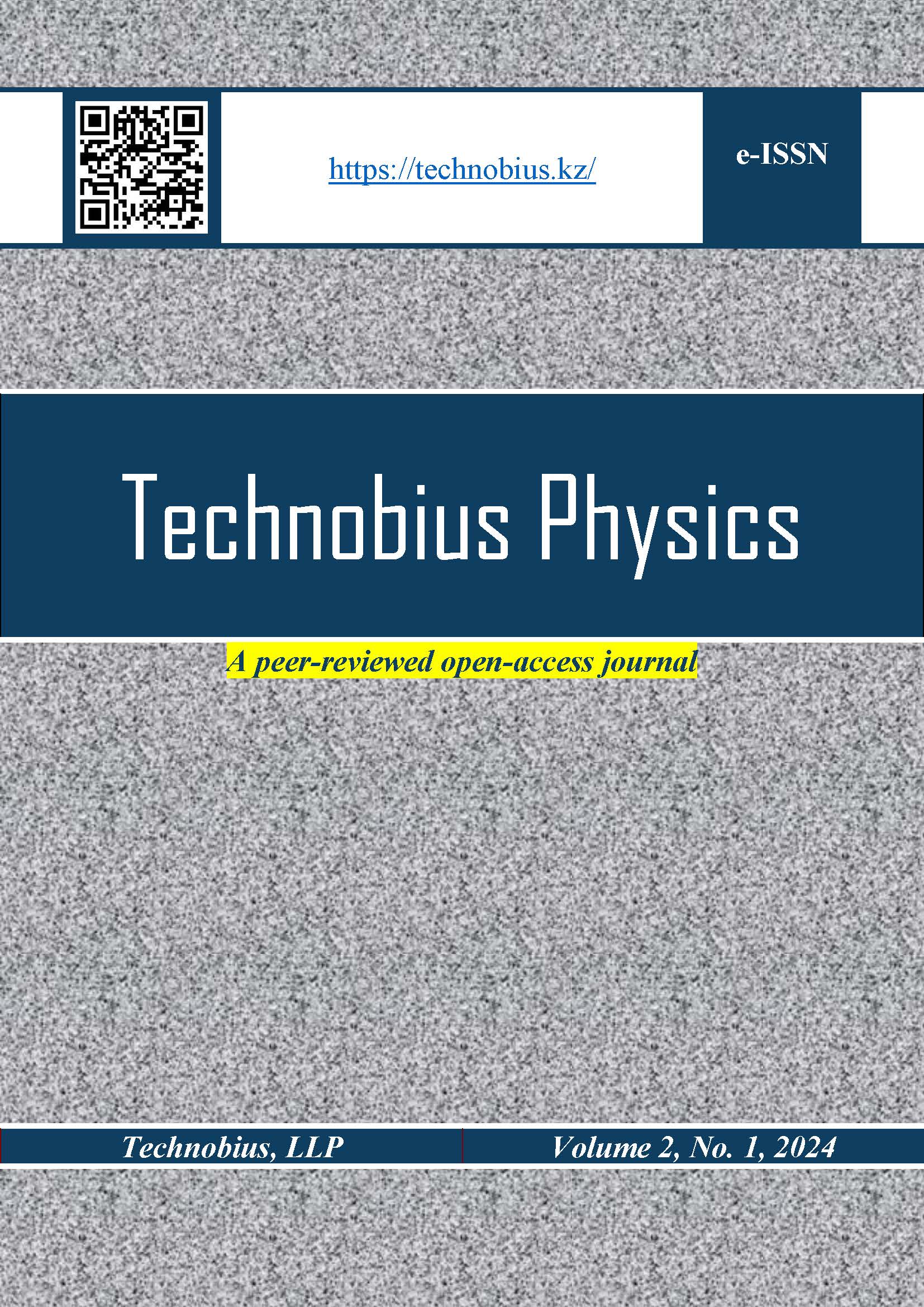Comparative analysis of copper X-radiation intensity with LiF and KBr crystals
Corrigendum
DOI:
https://doi.org/10.54355/tbusphys/2.1.2024.0007Keywords:
X-ray spectroscopy, Bragg angle, copper X-radiation, crystallographic phenomena, energy determinationAbstract
Corrigendum Notice: A corrigendum has been issued for this article and is included at the end of this document. Referred to by:
The intensity of copper X-radiation has been scrutinized as a function of the Bragg angle, employing both LiF and KBr crystals. X-ray intensity spectra were recorded for Cu as a function of Bragg angle using LiF, KBr single crystals using a PHYWE X-Ray Expert Unit (35 kV, 1 mA) with an X-ray goniometer, Plug-in Cu X-ray tube and a 2.2 mm diameter aperture tube. The scanning range was chosen to be 4°-55° for LiF and 3°-75° for KBr. The resultant spectra furnish a comprehensive portrayal of the variation in X-ray emission intensity relative to alterations in the Bragg angle. This investigation contributes to our comprehension of crystallographic phenomena and underscores the efficacy of diverse crystalline materials in X-ray diffraction studies. Precise determinations of the energy levels for characteristic copper X-ray lines have been obtained, revealing E (Kβ) = 8868.374 ± 30.474 eV and (Kα) = 8026.349 ± 31.634 eV. These findings accentuate the significance of X-ray spectroscopy in delineating the elemental composition and structural attributes of materials, while also affirming the role of theoretical predictions in elucidating experimental observations.
Downloads
Metrics
References
Empirical K-shell ionization cross-sections of elements from 4Be to 92U by proton impact / A. Kahoul, M. Nekkab, B. Deghfel // Nuclear Instruments and Methods in Physics Research, Section B: Beam Interactions with Materials and Atoms. — 2008. — Vol. 266, No. 23. — P. 4969–4975. https://doi.org/10.1016/j.nimb.2008.09.008 DOI: https://doi.org/10.1016/j.nimb.2008.09.008
Feasibility study of thin films deposited on a self-supporting carbon grid substrate target on the measurement of atomic inner-shell ionization cross-sections impacted by 3-30 keV electrons / Z. C. Qian, Y. Wu, C. H. Chang, Y. Yuan, C. S. Mei, J. J. Zhu, K. Moharram // EPL. — 2017. — Vol. 118, No. 1. — Article number. 13001. https://doi.org/10.1209/0295-5075/118/13001 DOI: https://doi.org/10.1209/0295-5075/118/13001
Present status of the experimental L-shell ionization cross sections for light ion impact / I. Orlic // Nuclear Instruments and Methods in Physics Research Section B: Beam Interactions with Materials and Atoms. — 1994. — Vol. 87, No. 1. — P. 285–292. https://doi.org/10.1016/0168-583X(94)95274-4 DOI: https://doi.org/10.1016/0168-583X(94)95274-4
Theoretical models to calculate stopping and ionization ratios of H2+ molecules in solid targets / C. D. Archubi, N. R. N. Arista // Physical Review A. — 2019. — Vol. 99, No. 3. — Article number 032702. https://doi.org/10.1103/PhysRevA.99.032702 DOI: https://doi.org/10.1103/PhysRevA.99.032702
Cooper-minimum-type structure in proton-induced L1- and L3- subshell x-ray line intensities of Pd measured with high-resolution x-ray spectroscopy / M. Kavčič, Ž. Šmit // Physical Review A. — 2009. — Vol. 79, No. 5. — P. 052708. https://doi.org/10.1103/PhysRevA.79.052708 DOI: https://doi.org/10.1103/PhysRevA.79.052708
Phase Assemblage of the Li+,Na+,K+||F–,Cl–,Br– Five-Component Reciprocal System and Its LiF–KCl–KBr–NaBr–NaCl Stable Pentatope / A.V. Burchakov, I. K. Garkushin, U. A. Emel’yanova Russian Journal of Inorganic Chemistry. — 2023. — Vol. 68, No. 7. — P.889–897. https://doi.org/10.1134/S003602362360082X DOI: https://doi.org/10.1134/S003602362360082X
3D Atomic Arrangement at Functional Interfaces Inside Nanoparticles by Resonant High-Energy X-ray Diffraction / V. Petkov, B. Prasai, S. Shastri, T.-Y. Chen // ACS Applied Materials and Interfaces. — 2015. — Vol. 7, No. 41. — P. 23265–23277. https://doi.org/10.1021/acsami.5b07391 DOI: https://doi.org/10.1021/acsami.5b07391
Measurement of Fall Rate and Analysis of Atmospheric Falling Dust in Duhok Governorate of Iraq by Using Atomic Absorption Spectrometry and X-ray Diffraction / B.H. Mahdi // Journal of Physics: Conference Series. — 2021. — Vol. 1829. — P. 012001. https://doi.org/10.1088/1742-6596/1829/1/012001 DOI: https://doi.org/10.1088/1742-6596/1829/1/012001
Inhomogeneous thermal expansion of metallic glasses in atomic-scale studied by in-situ synchrotron X-ray diffraction / A.H. Taghvaei, H. Shakur Shahabi, J. Bednarčik, J. Eckert // Journal of Applied Physics. — 2015. — Vol. 117, No. 4. — P. 187–195. https://doi.org/10.1063/1.4906552 DOI: https://doi.org/10.1063/1.4906552
Study of the structural quality of heteroepitaxial silicon-on-sapphire structures by high-resolution X-ray diffraction, X-ray reflectivity, and electron microscopy / A.E. Blagov, A.L. Vasiliev, A.S. Golubeva, I.A. Ivanov, O.A. Kondratev, Yu.V. Pisarevsky, M.Yu. Presnyakov, P.A. Prosekov, A.Yu. Seregin // Crystallography Reports. — 2014. — Vol. 59, No. 3. — P. 315–322. https://doi.org/10.1134/S1063774514030043 DOI: https://doi.org/10.1134/S1063774514030043
Downloads
Published
How to Cite
License
Copyright (c) 2024 Dias Sagatov

This work is licensed under a Creative Commons Attribution-NonCommercial 4.0 International License.








